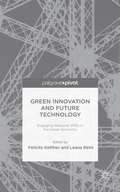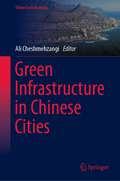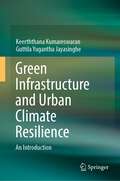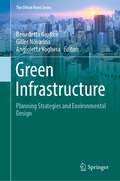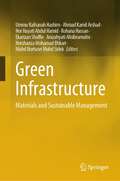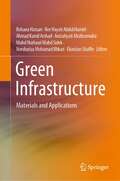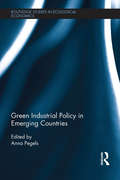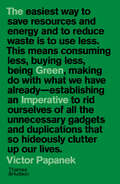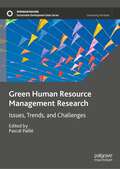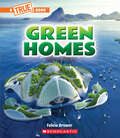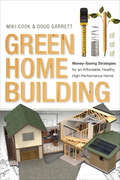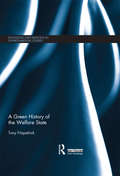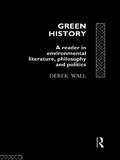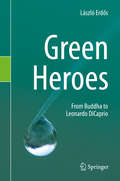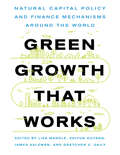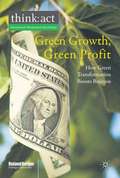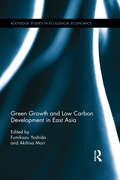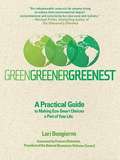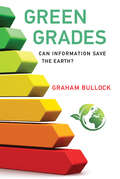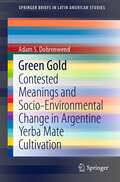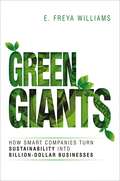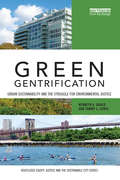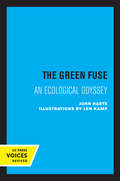- Table View
- List View
Green Innovation and Future Technology: Engaging Regional SMEs in the Green Economy
by Felicity Kelliher Leana ReinlThis book explores green innovation and future technology skill development within regional small to medium sized enterprises. Notwithstanding the goals of a greener Europe, there has been little debate as to how the skills required to fulfil the goals of sustainable development can be imparted within regions and within rural business communities.
Green Infrastructure in Chinese Cities (Urban Sustainability)
by Ali CheshmehzangiSince 2014, and the start of the New-type Urbanization Plan (NUP), we see a turning point in the sustainability agenda of China. One of the main indicators is greening cities and the built environments, which will be covered holistically in this edited book. From the perspective of green infrastructure, in particular, the book approaches key areas of ‘forest city development’, ‘sponge city program’, ‘green roofing’, ‘nature-based solutions’, ‘urban farming’, ‘eco-city development’, etc. This is the first time that such important areas of research come together under the perspective of green Infrastructure. The results would be beneficial to policymakers, practitioners, and researchers in China and across the globe. The comprehensive set of findings from this book will benefit other countries, as we aim to highlight some of the best practices of the current age.The main aim of the book is to put together an excellent group of scholars and practitioners from the field, focusing on the topic of ‘Green Infrastructure in Chinese Cities’. In doing so, we aim to cover some of the key ‘best practices’ for sustainable urbanism. Divided into four parts, the book covers four key areas of (1) Policy Interventions, (2) Planning Innovation, (3) Design Solutions, and (4) Technical Integration. In doing so, we cover an array of best practices related to green infrastructures of various types and their impacts on cities and communities in China.We expect the book to be a valuable resource for researchers in the areas of sustainability, urbanism, urban planning, urban geography, urban design, geographical sciences, environmental sciences, landscape architecture, and urban ecology. The book covers essential factors such as policy, regulations, and programs (in Part 1), planning paradigms and their impacts on urban development (in Part 2), integrated design solutions that suggest sustainable urbanization progression (in Part 3), and technical knowledge that would be utilized for the future development of green infrastructure practices in China and beyond. Lastly, this edited book aims to provide a collaborative opportunity for experts and researchers of the field, who could contribute to the future pathways of sustainable urbanization of China. Lessons extracted from these contributions could be utilized for other contexts, which will benefit a wider group of stakeholders.
Green Infrastructure and Urban Climate Resilience: An Introduction
by Keerththana Kumareswaran Guttila Yugantha JayasingheThis book aims to cover most subject areas of green infrastructure such as components, multi-functionality, and integration to build environment, contribution to urban sustainability, sustainable and smart city development, urban climate change nexus, green buildings and rating systems, economic assessment, and quantification of green infrastructure. The impending climate crisis, as well as the ongoing COVID-19 pandemic, has highlighted the importance of green infrastructure in and around cities, prompting a call for more functional and sustainable urban planning and design. A number of recent studies have shown that green infrastructure provides a wide range of ecosystem functions and services critical to human well-being and urban sustainability, which is especially important during climatic and health crises. In this book, the authors emphasize the importance of existing green infrastructure in coping with climate change-induced stresses, such as increasing climate variability and extreme temperature and precipitation events, as well as contributing to urban dwellers' physical and mental health. Green infrastructure, in both cases, plays a significant role in providing urban areas with resilience capacity, which is critical to urban sustainability. The authors also emphasize the importance of expanding and improving green infrastructure, particularly in vulnerable areas, through integrative and participatory processes.Appropriate integration of green-gray infrastructure and development of climate resilient cities is the core theme of this publication. Further, it emphasizes sustainable development which has become an imperative requirement to the world to move fore and climate change-built environment nexus, the most critical global crisis. Though several books were published globally on the green infrastructure and urban resilience individually, books are rarely published combining both disciplines. This book identifies and addresses the gap through comprehensively discussing on both interlinked areas which is essential for the sustainable urban development. Further, it explores on urban climate resilience, urban sprawl, urbanization, resilience drivers, essentials of city resilience, policy implications, challenges, and future perspectives. This book is a useful fundamental guide in practical applications of green infrastructure in built environment in sustainability context. Further, it enlightens on the significance of transforming the conventional building construction trend to sustainable urban planning designs and building development, exploring on the strategic pathway on building urban climate resilience while signifying the importance of healthy built environment through discussing on the nexus between climate change and built environment.
Green Infrastructure: Planning Strategies and Environmental Design (The Urban Book Series)
by Benedetta Giudice Gilles Novarina Angioletta VogheraThis book analyses international Green Infrastructure (GI) planning and design strategies. The GI strategy is widely recognized for its multifunctionality (as a tool for ecological, economic and social enhancement) and multiscalarity. Starting from this assumption, the book intends to implement the concept of GI and blue networks in planning strategies and their linked urban projects. New urban and regional paradigms of the latest years, such as urban sprawl, ecosystem services, biodiversity, urban resilience, climate change and health emergencies, have made it necessary to rethink cities and territories and their related plans and projects. To satisfy these paradigms, worldwide plans and projects have started to focus both on short-term and long-term processes and strategies which integrate environmental, landscape and ecological elements. Chapters 1 and 6 are available open access under a Creative Commons Attribution 4.0 International License via link.springer.com.
Green Infrastructure: Materials and Sustainable Management
by Ummu Raihanah Hashim Ahmad Kamil Arshad Nor Hayati Abdul Hamid Rohana Hassan Ekarizan Shaffie Anizahyati Alisibramulisi Norshariza Mohamad Bhkari Muhd Norhasri Muhd SidekThis second volume of "Green Infrastructure" provides a comprehensive exploration of both established and evolving green infrastructure materials, along with sustainable practices across various facets that hold the potential to shape our future. Emphasizing emerging domain materials such as timber, concrete, soil, and pavement, among others, this book delves into the pivotal role these elements play in fostering sustainable urban development. It underscores the significance of these materials in preserving ecosystem services and constructive management, thus leading to the attainment of manifold advantages. Bridging a critical void in the existing literature, this volume serves as an indispensable resource, serving to guide forthcoming research endeavors concerning green materials and their applications within the realm of sustainability.
Green Infrastructure: Materials and Applications
by Rohana Hassan Nor Hayati Abdul Hamid Ahmad Kamil Arshad Anizahyati Alisibramulisi Muhd Norhasri Muhd Sidek Norshariza Mohamad Bhkari Ekarizan ShaffieThis book presents the meaning of green infrastructure and its concerns to the contribution of materials and applications. It explores the evolving contested material under “green infrastructure” covering timber, concrete, soil, and pavement. It discusses the resistance to the ambiguity of managing the construction of green infrastructure and drawing on wider debates around applications and processes on construction. These contributions are by no means definitive, but rather an attempt to provide a detached and holistic perspective on the engineering “green infrastructure” concept.
Green Industrial Policy in Emerging Countries (Routledge Studies in Ecological Economics #34)
by Anna PegelsFor decades, governments have tried to foster industrial competitiveness and economic growth. Many instruments are known to work, and many lessons have been learned. However, humanity is increasingly feeling the effects of natural resource depletion. The rate of this depletion is deeply unsustainable, and it is – as of yet – inextricably linked to economic growth and development. To preserve acceptable living conditions for future generations, while at the same time creating these conditions for millions of poor in the first place, we must achieve a de-linking of economic activity and resource depletion. This book identifies the drivers and success factors of green industrial policy, which seeks to reconcile the synergies and trade-offs which exist between economic and environmental goals. Greening the economy is a goal which will require enormous investment. As markets are currently failing to provide the required incentives for environmental sustainability, governments must intervene and provide ‘policy rents’ for investments in sustainability while withdrawing rents from polluting investments. In this they will face the risk of political capture by interest groups and difficult choices among technologies. Rent management is therefore the heart of green industrial policy and the focus of this book. On top of this, the country examples provided in this volume focus on the emerging powers, which will have an important influence the future of our planet. However, the lessons learned are valuable not only for countries introducing green industrial policies for the first time, but also for those under pressure to reform existing policies. This book will be of interest to students, researchers and policymakers in the areas of energy policy, sustainable development, industrial economics and ecological economics.
The Green Imperative: Ecology and Ethics in Design and Architecture
by Victor PapanekA fresh edition of the sustainable design pioneer Victor Papanek’s classic and ever-relevant book examining the important role of design in combating climate change. Whether it’s horror at the plastic littering the world’s beaches or despair at the melting polar ice caps, the world is gradually waking up to the impending climate disaster. In The Green Imperative, Papanek argues for design that addresses these issues head-on. This means using materials that can be recycled and reused, no more pointless packaging, thinking about how products make us feel and engage all our senses, putting nature at the heart of design, working at a smaller scale, rejecting aesthetics for their own sake, and thinking before we buy. First published at the end of the twentieth century, this book offered a plethora of honest advice, clear examples, and withering critiques, laying out the flaws of and opportunities for the design world at that time. A quarter of a century on, Papanek’s lucid prose has lost none of its verve, and the problems he highlights have only become more urgent, giving today’s reader both a fascinating historical perspective on the issues at hand and a blueprint for how they might be solved.
Green Human Resource Management Research: Issues, Trends, and Challenges (Sustainable Development Goals Series)
by Pascal PailléIn contemporary times, most organizational functions (such as finance, marketing, and supply chains) have assessed their impact on the environment. HR has lagged behind other disciplines in discussions of sustainability, though the literature on this topic has grown significantly in recent years. This book, engaging SDGs 4 and 8, among others, examines green HRM from a variety of perspectives. Divided into three sections, it explores the process of human resource acquisition, the connection between green HRM practice and employee behavior, and international perspectives of green HRM. The final chapter presents a summary analysis of topics discussed in the book and outlines potential future paths of research for the field. This volume, featuring leading researchers from across the globe, further develops this emerging field for HR and organizational behavior scholars.
Green Homes (A True Book (Relaunch))
by Felicia BrowerEnvision a brighter future with this STEM-based subset of True Books.Small changes over the years = from smarter light bulbs to energy-efficient appliances = have made our homes more environmentally friendly. In recent years we have learned how to make alternative energies and Earth-friendly building methods and materials a reality. Today we understand how to build green homes = dwellings that have zero negative impact on the environment. Green Homes will show you how.ABOUT THE SERIES:What would a green future look like? Will trains and airplanes be powered by the sun? Will we have homes that have zero impact on the environment? The most pressing challenge facing us today is how to ensure a healthy Earth for ourselves and future generations. This STEM-based set of A True Books introduces students to the engineering innovations that can help us reach those goals. Interesting information is presented in a fun, friendly way = and in the simplest terms possible = and will inspire kids to start envisioning and enacting a more sustainable future.
Green Home Building: Money-Saving Strategies for an Affordable, Healthy, High-Performance Home
by Doug Garrett Miki CookAccording to conventional wisdom, building a green home is an expensive endeavor. The standard approach treats green as an add-on, tacking "premium" products, finishes, and equipment onto a traditional home design. As a result, many green home projects end up over budget or fail to achieve their environmental and performance goals.Green Home Building explodes the myth that green homes have to cost more. Using proven methods based on applied building science, the authors show how to: Lower base construction costs to provide funding for high performance upgrades Achieve a net-zero energy home, including "zero-ing" water, waste, carbon, and associated costs within fifteen years Live affordably into the future, despite anticipated rising costs for fuel, water, materials, taxes, and health careThis comprehensive guide to building green on any budget defines the strategies that maximize the return on green investments. Written for anyone who has ever been swayed by the argument that the price tag limits how green a home can be, Green Home Building is a must-read for builders, contractors, architects, designers, and homeowners.Miki Cook is a green building and sustainability consultant who has dedicated her career to educating contractors and the public on the strategies, methods, and benefits of green homes.Doug Garrett has trained thousands of homebuilders, architects, and sub-contractors to build energy-efficient homes using applied building science to improve comfort, durability, and healthfulness while meeting or exceeding the energy code.
A Green History of the Welfare State (Routledge Explorations in Environmental Studies)
by Tony FitzpatrickEnvironmental problems – particularly climate change – have become increasingly important to governments and social researchers in recent decades. Debates about their implications for social policies and welfare reforms are now moving towards centre stage. What has been missing from such debates is an account of the history of the welfare state in relation to environmental issues and green ideas. A Green History of the Welfare State fills this gap. How have the environmental and social policy agendas developed? To what extent have welfare systems been informed by the principles of environmental ethics and politics? How effective has the welfare state been at addressing environmental problems? How might the history of social policies be reimagined? With its lively, chronological narrative, this book provides answers to these questions. Through overviews of key periods, politicians and reforms the book weaves together a range of subjects into a new kind of historical tapestry, including: social policy, economics, party politics, government action and legislation, and environmental issues. This book will be a valuable resource for students and scholars of environmental policy and history, social and public policy, social history, sociology and politics.
Green History: A Reader in Environmental Literature, Philosophy and Politics
by Derek WallGreen History traces the development of ecological writing through history and forms a broad critical review of green ideas and movements reinforcing the importance of environmental concern and action in our own time. Animal rights, ecology as science, feminism, green fascism/socialism/anarchism, land reform, peaceful protest, industrialization, ancient ecology, evolution, grassroots activism, philosophical holism, recycling, Taoism, demographics, utopias, sustainability, spiritualism ...all these issues and many more are discussed. Authors include Alice Walker on massacre in the City of Brotherly Love, Aldous Huxley on progress, Lewis Mumford on the organic outlook, Engels on natural dialectics, Thoreau on the fontier life, the Shelleys on vegetarianism and playing God, Bacon on the New Atlantis, Hildegard of Bingen on green vigour, the unknown writer of the Bodhisattva and the Hungry Tigress and Plato on soil erosion. Each article is set within its historical and thematic context. A full introduction and a guide to further reading are also provided.
Green Heroes: From Buddha to Leonardo DiCaprio
by László ErdősThis book provides an introduction into the diversity of the environmental movement through great characters in the green sector. The book describes inspiring personal achievements, and at the same time it provides readers with information regarding the history, the main directions and the ethical principles of the environmental movement. Some of the most important characters of the movement from all around the world, are included in the book. As well as the title characters, Buddha and Leonardo DiCaprio, other famous environmentalists like Albert Schweitzer, David Attenborough and Jane Goodall are discussed. Some of the less well-known but equally important environmentalists such as Chico Mendes, Bruno Manser, Henry Spira, Tom Regan or Rossano Ercolini are highlighted in the various chapters. The selection of characters represents all major branches within the green sector, ranging from medieval saints to Hollywood celebrities, from university professors to field activists, from politicians to philosophers, from ecofeminists to radicals.
Green Growth That Works: Natural Capital Policy and Finance Mechanisms from Around the World
by Gretchen Daily Lisa Mandle Zhiyun Ouyang James E. SalzmanRapid economic development has been a boon to human well‑being, but comes at a significant cost to the fertile soils, forests, coastal marshes, and farmland that support all life on earth. If ecosystems collapse, so eventually will human civilization. One solution is inclusive green growth—the efficient use of natural resources. Its genius lies in working with nature rather than against it. Green Growth That Works is the first practical guide to bring together pragmatic finance and policy tools that can make investment in natural capital both attractive and commonplace. Pioneered by leading scholars from the Natural Capital Project, this valuable compendium of proven techniques can guide agencies and organizations eager to make green growth work anywhere in the world.
Green Growth, Green Profit
by Roland BergerGreen business is here. It is a multi billion business with enormous growth potential, driven by megatrends such as demographic change, climate change and urbanization. It is driving the transformation of existing businesses and changing the way customers and suppliers act, forcing them to rethink their business strategy.
Green Growth and Low Carbon Development in East Asia (Routledge Studies in Ecological Economics)
by Akihisa Mori Fumikazu YoshidaThe concept of green growth, coupled with one of green economy and low carbon development, is a global concern especially in the face of the multiple crises that the world has faced in recent years - climate, oil, food, and financial crises. In East Asia, this concept is regarded as the key in transforming cheap-labour dependent, export-oriented industries towards a more sustainable development. Green Growth and Low Carbon Development in East Asia examines the beginnings of low carbon, green growth in practice in East Asia and how effectively it has directed East Asian nations, especially Korea, China and Japan, to put environment and climate challenges as the core target zone for investment and growth. Special focus is paid to energy and international trade - areas in which these nations compete with pioneered nations of Europe and the United States to develop renewable energy industries and enhance their international competitiveness. On the basis of the lessons learned in East Asia, together with a comparison of Russia, this book discusses the applicability and limitations of this developmental approach taken by the developing nations and resource-rich emerging economies, including the conditions and contexts in which nations are able to transition into sustainable development through the use of low carbon, green growth strategies.
Green, Greener, Greenest
by Lori Bongiorno Frances BeineckeHow green can you be? Green: Drive the speed limit Greener: Drive a fuel-efficient car Greenest: Bike or walk The perfect guide to help readers decide how to best spend their time and money to protect the environment, Green, Greener, Greenest offers flexible tips for everyday living, all categorized as "green," "greener," and "greenest." Cutting through the labeling and the hype, it helps readers choose the advice that fits their schedule, their budget, and their interests, with the understanding that there's never one "right way" to make a difference. This indispensable resource will grow with readers-whether a novice in green living or a veteran environmentalist-as their interests and needs change over time.
Green Grades: Can Information Save the Earth?
by Graham BullockA comprehensive assessment and analysis of the validity, trustworthiness, and effectiveness, of such environmental ratings as ENERGY STAR, LEED, and USDA Organic. Consumers are confronted with a confusing array of environmental ratings on products that range from refrigerators to shampoos. Is the information that these ratings represent trustworthy, accurate, or even relevant to environmental concerns? “Information optimists” believe that these “green grades” can play an important role in saving the planet. “Information pessimists” consider them a distraction from pursuing legislative and regulatory actions. In this book, Graham Bullock offers a comprehensive assessment and analysis of the effectiveness and validity of such environmental ratings as ENERGY STAR, USDA Organic, the Forest Stewardship Council, LEED, and the Toxic 100 Air Polluters Index. Bullock stakes out a position as an “information realist,” acknowledging both the contributions and the limitations of these initiatives. Drawing on interviews, case studies, and an original dataset of 245 environmental ratings and certifications, he examines what he calls the information value chain of green grades: organizational associations, content, methods, interfaces, and outcomes. He explores the relevance of the information to the issues; the legitimacy and accountability of sponsoring or cooperating organizations; the reliability of methods used to develop the information; the prominence and intelligibility of communication to the public; and the effects and effectiveness of the information after it emerges from the value chain. Bullock's analysis offers a realistic appraisal of the role of information-based environmental governance—its benefits and shortcomings—and its relation to other governance strategies.
Green Governance
by Burns H. Weston David BollierThe vast majority of the world's scientists agree: we have reached a point in history where we are in grave danger of destroying Earth's life-sustaining capacity. But our attempts to protect natural ecosystems are increasingly ineffective because our very conception of the problem is limited; we treat "the environment" as its own separate realm, taking for granted prevailing but outmoded conceptions of economics, national sovereignty, and international law. Green Governance is a direct response to the mounting calls for a paradigm shift in the way humans relate to the natural environment. It opens the door to a new set of solutions by proposing a compelling new synthesis of environmental protection based on broader notions of economics and human rights and on commons-based governance. Going beyond speculative abstractions, the book proposes a new architecture of environmental law and public policy that is as practical as it is theoretically sound.
Green Gold: Contested Meanings and Socio-Environmental Change in Argentine Yerba Mate Cultivation (SpringerBriefs in Latin American Studies)
by Adam S. DohrenwendThis book applies an approach to study the externalization of cost under capitalism in the production of Argentine yerba mate, an infusion with stimulant properties long used by indigenous peoples. Consumption in today’s globalized economy makes it difficult to understand the consequences of our actions across the globe. A political-ecological lens, informed by the work of Robert Sack and Ian Cook, can help guide an analysis that geographically reconstructs supply chains and reveal the realities of consumption. The use of yerba mate has become a cornerstone of Argentine society and identity, and yerba mate processors are working to expand exports globally. In Argentina’s Misiones Province, the heart of yerba mate production, the true costs of production are borne by the children, the impoverished laborers, and the environment of Argentina’s Atlantic Rainforest. These consequences of modernity, along with the efforts of an NGO to remedy them, are presented and assessed.
Green Goes with Everything
by Sloan BarnettImagine if your best friend gave you vital information that could protect you and your family, and save you money, and help the planet. Imagine if you were given clear, simple choices, small changes that could have a big impact on your life. And you could still wear leather shoes and deodorant. You'd listen, right? Well, think of Today show contributor Sloan Barnett as that friend. A mother of three, a dedicated consumer advocate, Sloan gives us a fast, simple, down-toearth primer on the ways our homes are making us sick, and what we can all do to transform them into the safe sanctuaries we want and need them to be. Sloan exposes the toxic truth behind the household products we use every day -- from laundry detergent to toothpaste to lipstick. She explains how these and other seemingly benign stuff can harm us and our children. She offers an array of alternatives, and inspires us to see that we're never helpless: Every day, we have the power to make better, smarter, safer choices. Packed with common sense and sass, product picks and practical tips, Green Goes With Everything is for everyone who wants to live a healthier life.
Green Giants: How Smart Companies Turn Sustainability into Billion-Dollar Businesses
by E. Freya WilliamsWhat do Brazil's top beauty brand, America's second-fastest-growing restaurant chain, and the world's third bestselling car have in common? They are shattering the myth that acting sustainably and building a billion-dollar business are mutually exclusive.Green Giants examines nine companies that are merging social responsibility with wild profitability--and reveals the six factors responsible for their success, including:Iconoclastic Leadership fueled by deep conviction and a rebellious streakDisruptive Innovation that uses sustainability to spur the development of radically better products and servicesA Higher Purpose that ignites the company--when the mission leads, profits followMainstream Appeal with positioning and packaging stripped of the crunchy cliches that alienate the average customer.This new breed of billion-dollar businesses proves it's possible to achieve enormous success while implementing sustainable principles that help consumers live better lives. Ranging from start-ups to business lines incubated within major multinationals, these companies collectively represent over $60 billion in revenue. What's more--many command wider profit margins and are growing faster than their conventional counterparts.Packed with eye-opening research, exclusive interviews, and enlightening examples from Chipotle, Toyota, Unilever, Tesla, General Electric, and more, Green Giants serves as a blueprint for sustainable success that anyone can follow.
Green Gentrification: Urban sustainability and the struggle for environmental justice (Routledge Equity, Justice and the Sustainable City series)
by Tammy L. Lewis Kenneth A. GouldGreen Gentrification looks at the social consequences of urban "greening" from an environmental justice and sustainable development perspective. Through a comparative examination of five cases of urban greening in Brooklyn, New York, it demonstrates that such initiatives, while positive for the environment, tend to increase inequality and thus undermine the social pillar of sustainable development. Although greening is ostensibly intended to improve environmental conditions in neighborhoods, it generates green gentrification that pushes out the working-class, and people of color, and attracts white, wealthier in-migrants. Simply put, urban greening "richens and whitens," remaking the city for the sustainability class. Without equity-oriented public policy intervention, urban greening is negatively redistributive in global cities. This book argues that environmental injustice outcomes are not inevitable. Early public policy interventions aimed at neighborhood stabilization can create more just sustainability outcomes. It highlights the negative social consequences of green growth coalition efforts to green the global city, and suggests policy choices to address them. The book applies the lessons learned from green gentrification in Brooklyn to urban greening initiatives globally. It offers comparison with other greening global cities. This is a timely and original book for all those studying environmental justice, urban planning, environmental sociology, and sustainable development as well as urban environmental activists, city planners and policy makers interested in issues of urban greening and gentrification.
The Green Fuse: An Ecological Odyssey
by John HarteA widely respected ecological scientist and activist draws on the poet's image and his own environmental research to demonstrate the many interconnections among the world's ecosystems. John Harte takes us from Alaskan salmon runs and the Florida everglades to South Pacific coral reefs and the bleak Tibetan plateau. The result is that rare book that bridges the cultures of science and art. Lyrical, vivid portraits of natural wonders and the threats to them are combined with precise scientific accounts of natural processes and their disturbances. The Green Fuse will show nonscientists the fascination of ecological detective work and renew scientists' love for the beauty of the world under their microscopes. Harte's stories illuminate, without sermonizing, the damage to natural systems brought about by technological hubris and calculated political ruthlessness. "The green fuse" symbolizes the basic unity behind natural diversity. But a fuse may also be the weak link in an overloaded system or the slow burning wick on an ecological bomb. As The Green Fuse reminds us, the energies that created human liberation from nature can also be those that lead to the human destruction of nature. This title is part of UC Press's Voices Revived program, which commemorates University of California Press’s mission to seek out and cultivate the brightest minds and give them voice, reach, and impact. Drawing on a backlist dating to 1893, Voices Revived makes high-quality, peer-reviewed scholarship accessible once again using print-on-demand technology. This title was originally published in 1993.
